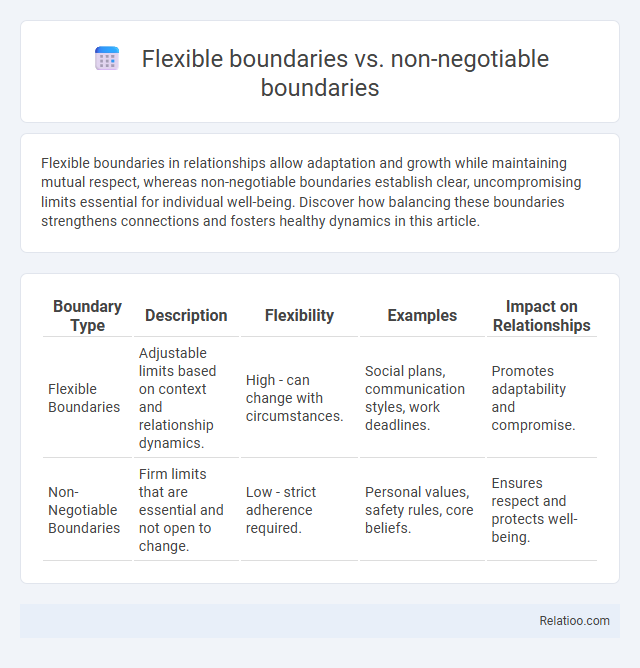Flexible boundaries in relationships allow adaptation and growth while maintaining mutual respect, whereas non-negotiable boundaries establish clear, uncompromising limits essential for individual well-being. Discover how balancing these boundaries strengthens connections and fosters healthy dynamics in this article.
Table of Comparison
| Boundary Type | Description | Flexibility | Examples | Impact on Relationships |
|---|---|---|---|---|
| Flexible Boundaries | Adjustable limits based on context and relationship dynamics. | High - can change with circumstances. | Social plans, communication styles, work deadlines. | Promotes adaptability and compromise. |
| Non-Negotiable Boundaries | Firm limits that are essential and not open to change. | Low - strict adherence required. | Personal values, safety rules, core beliefs. | Ensures respect and protects well-being. |
Understanding Boundaries: Flexible vs Non-Negotiable
Understanding boundaries involves recognizing the difference between flexible and non-negotiable limits that protect your well-being. Flexible boundaries allow adjustment based on context and relationships, promoting healthy interaction without compromising core values. Non-negotiable boundaries represent essential standards that you uphold firmly to maintain respect and personal integrity.
Key Differences Between Flexible and Non-Negotiable Boundaries
Flexible boundaries allow for adjustments based on context, promoting adaptability and compromise in relationships, whereas non-negotiable boundaries are rigid, reflecting core values or essential limits that must be respected without exception. Your emotional well-being thrives when you identify which boundaries can bend and which must stand firm to maintain personal integrity and mutual respect. Recognizing the key differences between flexible and non-negotiable boundaries empowers you to communicate your needs effectively and foster healthier interactions.
The Psychology Behind Setting Boundaries
Setting boundaries involves recognizing psychological needs for safety, respect, and autonomy, with flexible boundaries allowing adaptability in relationships to reduce stress and promote trust. Non-negotiable boundaries reflect core values and self-respect, serving as firm limits to prevent emotional harm and maintain mental health. Understanding these differences helps individuals navigate social interactions effectively, enhancing emotional well-being and personal empowerment.
Benefits of Flexible Boundaries in Relationships
Flexible boundaries in relationships promote adaptability and open communication, allowing partners to grow together while respecting individual needs. This approach fosters trust and emotional intimacy by accommodating changes without sacrificing core values. Benefits include reduced conflict, enhanced mutual understanding, and increased relationship satisfaction.
When Are Non-Negotiable Boundaries Essential?
Non-negotiable boundaries are essential when your core values, safety, or mental health are at stake, ensuring protection from harmful behaviors and situations. Flexible boundaries allow adjustment in less critical areas, fostering adaptability and compromise without compromising your well-being. Recognizing when to enforce non-negotiable limits safeguards your integrity and maintains respect in relationships.
Identifying Your Personal Boundary Needs
Identifying your personal boundary needs involves understanding the differences between flexible boundaries, which adapt to various situations without compromising core values, and non-negotiable boundaries, which are firm limits set to protect your emotional, physical, and mental well-being. Flexible boundaries allow for healthy relationship dynamics by permitting some give-and-take, whereas non-negotiable boundaries are essential for maintaining self-respect and preventing burnout. Clarifying these distinctions helps you communicate your limits effectively and fosters healthier interpersonal connections.
Navigating Conflict: Adjusting Flexible Boundaries
Navigating conflict requires understanding the differences between flexible boundaries, which allow for adaptability and compromise, and non-negotiable boundaries, which remain firm regardless of circumstances. You can adjust flexible boundaries to facilitate communication and resolution, while respecting the integrity of non-negotiable limits to maintain personal values and well-being. Balancing these boundary types helps manage conflicts effectively and fosters healthier relationships.
Enforcing Non-Negotiable Boundaries With Confidence
Enforcing non-negotiable boundaries requires clear communication and unwavering consistency to protect personal values and mental health effectively. Unlike flexible boundaries, which allow some adjustment based on circumstances, non-negotiable boundaries must be defined firmly and conveyed confidently to prevent misunderstandings and breaches. Development of self-awareness and assertiveness skills enhances the ability to enforce these boundaries without guilt or hesitation.
Common Mistakes in Setting and Maintaining Boundaries
Common mistakes in setting flexible boundaries include unclear communication and inconsistency, causing confusion and erosion of respect. Non-negotiable boundaries often fail when individuals avoid assertiveness or fail to reinforce limits, leading to boundary violations and emotional distress. Mixing flexible and non-negotiable boundaries without clear distinction can create ambiguity, undermining effectiveness and personal well-being.
Tips for Balancing Flexibility and Firmness in Boundaries
Balancing flexibility and firmness in boundaries requires clearly defining non-negotiable limits while allowing room for adaptable, flexible boundaries to accommodate changing circumstances. Prioritize communication skills such as assertiveness and empathy to effectively maintain respect for core values without creating unnecessary conflict. Regularly reassess boundaries to ensure they align with personal well-being, relationships, and professional goals, adjusting as needed to promote healthy interactions.

Infographic: Flexible boundaries vs Non-negotiable boundaries
 relatioo.com
relatioo.com